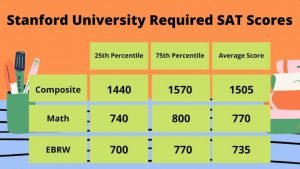Stanford University Requirements
Are you interested in knowing Stanford University requirements? If so, then this article is yours. Feel relaxed and make sure you read it to the end.

Stanford University Requirements:About 1,700 freshmen and 30 transfer students enroll at Stanford each year.
What are Stanford’s admission requirements? While there are a lot of pieces that go into a college application, you should focus on only a few critical things:
GPA requirements
Testing requirements, including SAT and ACT requirements
Application requirements
School location: Stanford, CA
This school is also known as: Stanford University
If you want to get in, the first thing to look at is the acceptance rate. This tells you how competitive the school is and how serious their requirements are.
The acceptance rate at Stanford is 4.3%. For every 100 applicants, only 4 are admitted.
This means the school is extremely selective. Meeting their GPA requirements and SAT/ACT requirements is very important to getting past their first round of filters and proving your academic preparation. If you don’t meet their expectations, your chance of getting in is nearly zero.
After crossing this hurdle, you’ll need to impress Stanford application readers through their other application requirements, including extracurriculars, essays, and letters of recommendation.
Stanford University requirements
What is Stanford University’s acceptance rate?
Last year Stanford University’s acceptance rate was 5.04. However, check out how the acceptance rate has changed over time.
| 2016 | 2017 | 2018 | |
|---|---|---|---|
| Acceptance Rate | 5.0 % | 5.0 % | 5.04 % |
As you can see, Stanford University is a little easier to get into than last year.
Acceptance rate alone does not indicate your likelihood for getting into Stanford University – it’s a very high level understanding of the true competition. Use the acceptance rate as a general guide for curating a list of 10-15 schools that fall into different ranges of competitiveness. Then, use the below data to get a deeper understanding of how your application will compare to the rest of the pool.
READ ALSO:MBA Admission Consulting Jobs
What GPA do you need to get into Stanford University?
Stanford GPA Requirements
Many schools specify a minimum GPA requirement, but this is often just the bare minimum to submit an application without immediately getting rejected.
The GPA requirement that really matters is the GPA you need for a real chance of getting in. For this, we look at the school’s average GPA for its current students.
Stanford University’s average GPA is 3.95. Stanford University does require GPA. This average GPA means Stanford University is brutally selective – the most competitive applicants in the world are already applying to the school, in hopes of taking up residence in Stanford, and, somehow, you need to be better. Generally speaking, if your GPA is not at least equal to 3.95 then Stanford University may be a reach. However, Stanford University considers the ENTIRE application – we can make up for a weak GPA with more factors that we’ll discuss below. If your GPA is equal to or greater than 3.95, you’re sitting right in the sweetspot.
Stanford University requirements
*BEFORE CONTINUING PLEASE NOTE: GPA and “prestige” DO NOT mean a college is right for you. Stanford University may seem amazing on paper, but you may hate it… That’s why 700,000 students transfer colleges every year – they end up going to the wrong school. It’s crucial to watch the videos on CampusReel and make sure you can envision yourself on Stanford University’s campus. These Stanford University admission statistics do not sufficiently tell you what a college or university is like.
SAT and ACT Requirements
Each school has different requirements for standardized testing. Most schools require the SAT or ACT, and many also require SAT subject tests.
You must take either the SAT or ACT to submit an application to Stanford. More importantly, you need to do well to have a strong application.
READ ALSO:Bullitt County Public Schools Calendar 2022 and 2023
Stanford SAT Requirements
Many schools say they have no SAT score cutoff, but the truth is that there is a hidden SAT requirement. This is based on the school’s average score.
The average SAT score composite at Stanford is a 1505 on the 1600 SAT scale.
This score makes Stanford Extremely Competitive for SAT test scores.
SAT Score Choice Policy
The Score Choice policy at your school is an important part of your testing strategy.
Stanford has the Score Choice policy of “All Scores.”
This means that Stanford requires you to send all SAT scores you’ve ever taken to their office.
This sounds daunting, but most schools don’t actually consider all your scores equally. For example, if you scored an 1300 on one test and a 1500 on another, they won’t actually average the two tests.
In fact, we researched the score policies at Stanford, and they have the following policy:
For the SAT, we will focus on the highest individual Critical Reading, Math and Writing scores from all test sittings.
Source
Some students are still worried about submitting too many test scores. They’re afraid that Stanford will look down on too many attempts to raise your score. But how many is too many?
From our research and talking to admissions officers, we’ve learned that 4-6 tests is a safe number to submit. The college understands that you want to have the best chance of admission, and retaking the test is a good way to do this. Within a reasonable number of tests, they honestly don’t care how many times you’ve taken it. They’ll just focus on your score.
If you take it more than 6 times, colleges start wondering why you’re not improving with each test. They’ll question your study skills and ability to improve.
But below 6 tests, we strongly encourage retaking the test to maximize your chances. If your SAT score is currently below a 1550, we strongly recommend that you consider prepping for the SAT and retaking it. You don’t have much to lose, and you can potentially raise your score and significantly boost your chances of getting in.
READ ALSO:OXFORD ACCEPTANCE RATE
Does Stanford University Require Test Scores?
Stanford University requires that you either take the SAT or ACT. See the table below for how Stanford University’s accepted students have performed on both tests. You may be wondering how many test scores should you submit. Generally, don’t freak out about taking the test too often. Industry consensus is that you can submit up to 6 tests as a reasonable limit.
Stanford University SAT Requirements
Stanford University’s average SAT score is 1480 – this is the sum of the math and reading portions of the SAT (the 1600 scale). Check out the below table for a deeper look into how students performed – it’s also very interesting to look at the average test score over time. The trend over time helps give insight into whether Stanford University is getting more or less competitive.
Stanford University requirements
Stanford ACT Requirements
Just like for the SAT, Stanford likely doesn’t have a hard ACT cutoff, but if you score too low, your application will get tossed in the trash.
Stanford University’s average SAT score is 1480. To be a competitive applicant for Stanford University your SAT score should come close to the average. If you’re closer to the 1380, you’re likely going to have a tougher time getting accepted. To consider Stanford University a “target” school (one that you are likely to get into) you should aim for a score of 1580.
The average ACT score at Stanford is 34. This score makes Stanford Extremely Competitive for ACT scores.
The 25th percentile ACT score is 32, and the 75th percentile ACT score is 35.
Even though Stanford likely says they have no minimum ACT requirement, if you apply with a 32 or below, you’ll have a very hard time getting in, unless you have something else very impressive in your application. There are so many applicants scoring 34 and above that a 32 will look academically weak.
ACT Score Sending Policy
If you’re taking the ACT as opposed to the SAT, you have a huge advantage in how you send scores, and this dramatically affects your testing strategy.
Here it is: when you send ACT scores to colleges, you have absolute control over which tests you send. You could take 10 tests, and only send your highest one. This is unlike the SAT, where many schools require you to send all your tests ever taken.
This means that you have more chances than you think to improve your ACT score. To try to aim for the school’s ACT requirement of 35 and above, you should try to take the ACT as many times as you can. When you have the final score that you’re happy with, you can then send only that score to all your schools.
ACT Superscore Policy
By and large, most colleges do not superscore the ACT. (Superscore means that the school takes your best section scores from all the test dates you submit, and then combines them into the best possible composite score). Thus, most schools will just take your highest ACT score from a single sitting.
However, in our research, we found that Stanford does in fact offer an ACT superscore policy. To quote their Admissions Office:
For the ACT, we will focus on the highest Composite and the highest Combined English/Writing scores from all test sittings. We will also consider individual subscores.
Source
Superscoring is powerful to your testing strategy, and you need to make sure you plan your testing accordingly. Of all the scores that Stanford receives, your application readers will consider your highest section scores across all ACT test dates you submit.
Click below to learn more about how superscoring critically affects your test strategy.
Therefore, if your ACT score is currently below a 35, we strongly recommend that you consider prepping for the ACT and retaking it. You have a very good chance of raising your score, which will significantly boost your chances of getting in.
Even better, because of the Superscore, you can focus all your energy on a single section at a time. If your Reading score is lower than your other sections, prep only for the Reading section, then take the ACT. Then focus on Math for the next test, and so on. This will give you the highest Superscore possible.
Stanford University Requirements
Now you know where you need to be for getting into Stanford University from a grade and test score perspective. Let’s quickly outline what else you’ll need to provide for your application to get reviewed, and then we’ll move onto the most important section: differentiating your app.
Recommendations Status
School Rank Neither required nor recommended
GPA Recommended
School Record Required
How to get into Stanford University
Follow these steps to maximize your chances of getting into Stanford University. Everything you read above will help prepare you for what you need to achieve to have a shot at Stanford University, but these steps will take you even further in applying that knowledge and differentiating your application.
Main Academic Excellence that is in line with Stanford University admission standards.
Score at least a 1480 on the SAT or 99 on the ACT.
Maintain a GPA of at least a 3.95.
Join Extracurriculars that Align with Stanford University’s Values.
Join your school band, a sports team or another group activity. If Stanford University values music heavily, for example, then try to participate in an organization related to that topic.
Volunteer in your hometown. Stanford has tons of ways to be involved beyond just the college. Stanford University wants applicants that are also good ambassadors for the school – they want students who will give back to the local community and broader Stanford area in general.
Spend your summer doing something that speaks to your values, personal growth, leadership qualities and other less quantifiable characteristics. Stanford University needs to see past your test scores and grades – they need to know that you will be a valuable and contributing member of their community. You are more than grades and test scores – your experiences should demonstrate that.
Prepare Your Application
Write a stellar essay that shows Stanford University something they can’t figure out from the other parts of your application. For a detailed guide on writing the best college essay, check this out.
Get teacher recs that speak to your character. If you know what you’re majoring in and include that in your Stanford University app, try to have at least 1 recommendation from a teacher in that department.
Apply Before the Deadline. Too many students wait until the last minute to submit their application, and too much can go wrong during this precious time window. Since many students are applying on the last day, it’s possible that Stanford University’s own system crashes. Don’t risk the added stress this can cause – submit your app a few days early.
Stanford University requirements
How hard is it to get into Stanford University?
As you can see from the data above, Stanford University is exceptionally difficult to get into. Not only should you be aiming for a 3.95 but also SAT scores around 1480. Getting into Stanford University is no easy feat and you will need to set yourself apart with more than just numbers and data. Read on to learn how.
SAT/ACT Writing Section Requirements
Both the SAT and ACT have an optional essay section.
Stanford requires you to take the SAT Essay/ACT Writing section. They’ll use this as another factor in their admissions consideration.
SAT Subject Test Requirements
Schools vary in their SAT subject test requirements. Typically, selective schools tend to require them, while most schools in the country do not.
Stanford has indicated that SAT subject tests are recommended. Typically this means that SAT subject tests are not required, but submitting them can showcase particular strengths. For example, if you’re applying to an engineering school, submitting science and math SAT subject tests will boost your application.
Typically, your SAT/ACT and GPA are far more heavily weighed than your SAT Subject Tests. If you have the choice between improving your SAT/ACT score or your SAT Subject Test scores, definitely choose to improve your SAT/ACT score.
Because this school is extremely selective, getting a high SAT/ACT score and GPA is vital to having a chance at getting in. If you don’t pass their SAT/ACT and GPA requirements, they’ll likely reject you without much consideration.
To have the best shot of getting in, you should aim for the 75th percentile, with a 1550 SAT or a 35 ACT. You should also have a 3.96 GPA or higher. If your GPA is lower than this, you need to compensate with a higher SAT/ACT score.
For a school as selective as Stanford, you’ll also need to impress them with the rest of your application. We’ll cover those details next.
But if you apply with a score below a 1550 SAT or a 35 ACT, you unfortunately start out with the odds against you and have a tiny chance of getting in. There are just too many students with high SAT/ACT scores and strong applications, and you need to compete against them.
Note: Your admission decision relies not only on your GPA and SAT/ACT scores, but also on your coursework difficulty, extracurriculars, letters of recommendation, and personal statements. This tool provides only a simplistic estimate of your chances of admission. Instead of treating this tool as a crystal ball, we recommend you consider the big picture of what your chance means:
80-100%: Safety school: Strong chance of getting in
50-80%: More likely than not getting in
20-50%: Lower but still good chance of getting in
5-20%: Reach school: Unlikely to get in, but still have a shot
0-5%: Hard reach school: Very difficult to get in
We recommend you apply to schools across a range of chances. Applying to some safety schools will guarantee you have a college to go to, while applying to some reach schools will give you a shot at getting into the school at the top of your range.







